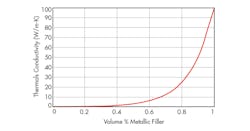Designing functional engineered systems using 3D printing requires more data on material properties. A paper that helped add some of the necessary data on the “Thermal Properties of 3-D Printing Polylactic Acid–Metal Composites” was published. Researchers aimed the study at copperFill, bronzeFill, magnetic iron polylactic acid (PLA), and stainless-steel PLA composites and provide insight into the technical considerations of fused filament fabrication (FFF) composite 3-D printing. The following is taken from this study.
Chicken or the Egg
Someone asked me, which came first, the 3D printer or the materials to 3D print with? When 3D printing was getting started in the 1980s, researchers used materials that worked well within the application. The materials came first, this new process was just a new way of using it. The printer technology was generally limited by the small material selection. However, with the growth 3D printing has seen in the last few years, new materials and combinations are hitting the market. This explosion of materials has greatly expanded 3D printing and now the technologies—machines and materials—are growing together.
Importance of Published Properties
With rapid growth, hype, and excitement it can be hard to keep up, and while 3D printing is cool, engineers still need the cold, hard facts to design parts. Without this data we’re all just printing chess pieces, which greatly limits 3D printing capabilities.
There is more than just the thermal conductivity of the materials. Density will affect thermal properties of the part. With the printing process, density can be altered by changing the fill inside the part. A part can be made to be hollow, solid, or any percentage of fill in between. However, the density of a part can also change with the percentage of metal fill in the polymer, too.
Calculating thermal conductivity could take into consideration the conductivity of both materials in their respective percentages, but air void fractions between each printed metal/polymer composite layer can cause inaccurate calculations and alter the thermal properties of the part. This can be mitigated by changing the printing parameters, specifically extrusion temperature and speed. The materials studied need a type of correction factor, or an air void fraction percentage.
In addition, the study concluded that density was greatly affected by the printing operation. This meant theoretical data didn’t match experimentally collected thermal conductivity values. More rigorous quantitative exercises are needed to track the changes in the porosity to obtain more accurate thermal conductivity data. However, the data gained from the study can be used to engineer thermal conductivity into 3-D printed parts with these PLA-based composites.
None of the materials tested had high thermal conductivities, but there could be applications for this. Material with low thermal conductivity but that looks like metal could increase insulation on windows. The part that holds the panes of glass apart, called a muntin, is often extruded metal. Lower thermal conductivity while maintaining a similar look may add value to these applications. However, this adds to the lack of data on these materials. How well does this material hold up to UV light and varying temperatures? Not having these properties is holding back many of these new materials from being used in more complex applications.
Conclusion
The study concluded, “Porosity coupled with lack of sufficient metal constituent cross section resulted in degraded thermal conductivity performance. Current manufacturing and secondary processing techniques have shown to increase the thermal conductivity of the matrix of copperFill, bronzeFill, magnetic iron PLA and stainless steel PLA by 81.28%, 98.81%, 45.66%, and 71.51%, respectively. While non-ideal results have surmounted after rigorous analysis, a proof of concept has been proposed. However, further work is required to maximize the metallic filler volume percent and thus increase available sites for thermal transfer.”
While these numbers sound impressive, thermal conductivity of PLA is low, so even a 98% increase is still low (PLA thermal conductivity is around 0.13 W/m-K). More research, such as this study, is needed to help engineers design parts for 3D printing with confidence.




